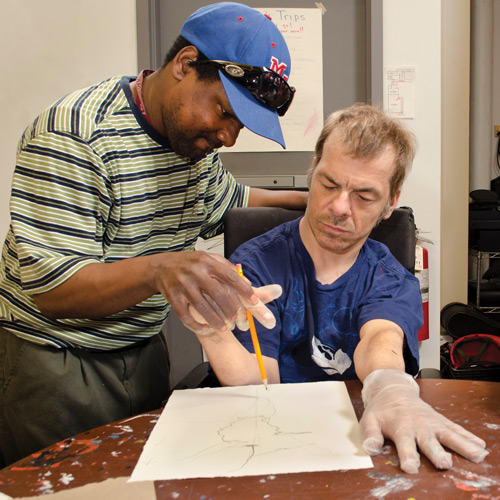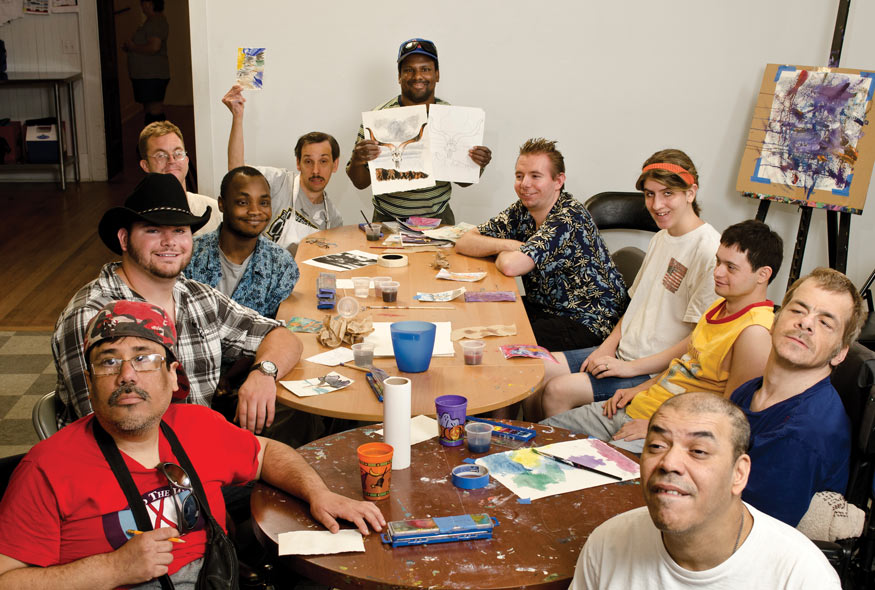
More important to share
Alton’s watercolor class at RHD Rhode Island’s Second Sight Studio begins promptly at 11 a.m., and Alton moves steadily around the table talking to his group of artists. He explains the day’s lesson, makes sure everyone knows that attending the class means committing to the whole hour and helps his student-colleagues take on their assignments.
“Take your time,” Alton says. “Watercolor is a slow process. There’s no pressure; take your time. Don’t rush. There is no rushing allowed in my class.”
At RHD Rhode Island’s day program for those with intellectual and developmental disabilities, the most popular activity may be a watercolor class taught by an instructor unusually attuned to his students’ abilities. Alton, known in art circles for his precise, highly technical creative work, is not only an art teacher. He’s also an RHD Rhode Island client who happens to have developmental disabilites. Alton is the first client at RHD Rhode Island to become so advanced and technically proficient that he’s begun instructing others.
But RHD Rhode Island is a place where, as program director Ray Memery puts it, the clients don’t just attend the program. They help shape it. So it’s natural that Alton, a rare talent with leadership ability, rose not only to the top of the class but also to the front of the class as its instructor. It’s a classic win-win, says Memery: the students are engaged and learning, and Alton continues to blossom as a result of the empowerment and responsibility.
“He’s our most naturally talented and gifted artist,” said Mark Stone, case manager and direct service professional at RHD Rhode Island. “The other consumers look up to him, both because of the quality of his work and because of the paychecks he generates at art shows. You’ll hear people say: I would like to be as good as Alton.”
RHD Rhode Island Arts Coordinator Nate Carroll said it all started when staff noticed clients approaching Alton to ask for help, and Alton responded with patience and sound instruction. The crowds around him began to grow. Staff approached Alton about teaching a formal, regularly scheduled class. Alton is active in the community, working with his church group and volunteering at a local high school. But this was something different.
“I had to be talked into it,” Alton said. “I was a little bit nervous at first. I thought I would try it out and see if I liked it. I wanted to get used to it. Now I want to keep on doing it.”

Alton happily shows off his latest project as he talks, a kaleidoscopic series of almost mathematical precision that he says comes naturally and easy to him.
“His work is fully formed in his head, and comes out on the page the way he imagined it, which is a really rare gift,” Carroll said. “He’s authentically self-taught, and has an innate technical knowledge. He made his own color wheel, with all the tints. I went to art school, and I can’t do that.”
Alton has a knack for imparting the technical, how-to aspects of creativity in a way students can grasp.
“He’s professorial,” Stone said. “His demeanor is serious. In the studio, he’s more peer-to-peer, but in the class he takes on the role of teacher. On his off days, he’s preparing for the next class.”
Each week, Carroll supplies a list of possible artists, and Alton looks each one up on a computer and samples their artwork for use in his class.
“I want something that is just right for the class – not too busy, but not boring,” he said.
This week, Alton settles on “Ram’s Head” by Georgia O’Keeffe. He draws a remarkable pencil copy for the students to emulate, in various sizes, with jaw-dropping precision and speed. Kirk, in a wheelchair with limited use of his arms, struggles to re-create the piece; Alton puts his hand on top of Kirk’s hand and leads the pencil across the paper.
Then they paint. While each student begins with a reasonably similar drawing, each finished works turn out wildly distinct. Each is a unique reflection of the artist – which is Alton’s aim.
“The fun part is teaching them how to do it,” Alton said. “The painting they can do their way. But the drawing part, they should get close to the way I have it. At least I’m getting them to try.”
Alton has a class of 10; a number the staff decided was manageable. It’s always full. Direct service professionals Tyler Grimes and Andy Mendillo stand close by, watching the class. Mendillo sat in for a few weeks and took the class as a student and saw his own work dramatically improve. He noted that Alton’s insistence that the students take the whole hour and work at Alton’s methodical pace produces some of their best work.
“With the hour, they take more time and pay more attention to their choices,” Mendillo said.
Toward the end of the hour, Jahnoy finally regards his work and announces: “Alton, I think I’m done.” Alton walks over and pats him on the shoulder, and Jahnoy excitedly jumps up with his painting in hand.
“I love Alton,” he says.
“It makes me feel proud,” Alton said.
Alton is now talking about teaching classes outside RHD Rhode Island some day.
“Painting relaxes me. It keeps me calm. I enjoy doing it,” Alton said. “When I was 21, I just felt that way. I wanted to become an artist. I think it’s important. I can give others ideas. I can give other classes ideas.
“I don’t want to keep it for myself. I want to share it and spread it around. To me, it’s more important to share it than to keep it to myself.”


